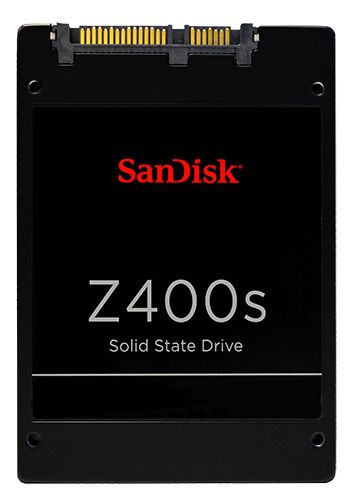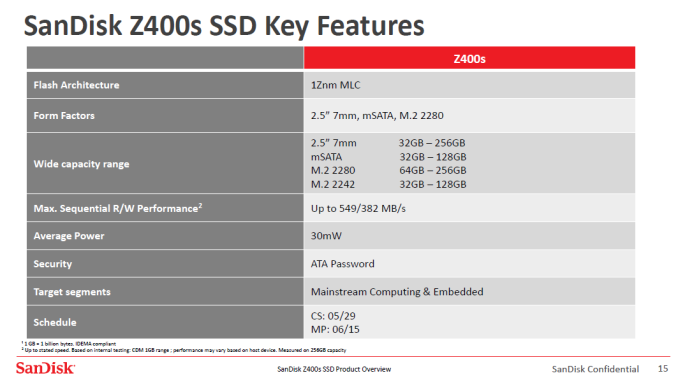SanDisk Releases Z400s SSD for Mainstream PCs & Embedded Applications
by Kristian Vättö on May 26, 2015 3:44 AM EST
With Computex only a week away, SanDisk is taking a head start today with the release of Z400s SSD. SanDisk is aiming to cater two different markets with the X400s, the first one being the traditional mainstream PC space where SanDisk is looking to bring low-capacity drives at an affordable price, and the other one is the embedded market that includes applications such as digital signage, point of sale and surveillance.
Embedded devices still rely heavily on hard drives because the upgrade cycles tend to be long and the cost of SSDs hasn't been low enough to attract interest over hard drives. Most embedded devices often have only one key function, which is why the market hasn't seen SSDs as a viable solution until recently when low-capacity SSDs have become cost competitive with hard drives. Because the applications don't typically need more than a few dozen gigabytes, SanDisk is offering the Z400s in capacities from 32GB to 256GB in a variety of form factors including M.2 and mSATA. The reason why SanDisk isn't offering any higher capacity options is because the average client SSD capacity is still well below 256GB (~180GB according to SanDisk's own research), so since the Z400s is aimed for the hard drive replacement crowd the company wanted to keep the available options as low cost as possible.
As usual, SanDisk isn't disclosing the controller inside the Z400s, but given SanDisk's history I would guess it's a 4-channel Marvell silicon, although I wouldn't be surprised to see a Silicon Motion or JMicron controller for further cost reductions (Marvell's controllers are relatively expensive compared to others). The Z400s turns out to be SanDisk's, and world's, first SSD to utilize 15nm NAND, which has certainly spent a long time in making. I posted a preliminary analysis on Toshiba-SanDisk's 15nm NAND in last August, but we'll know more once the drives ship and the die is put under a microscope. From what I have heard the supply of 15nm is still very limited, but we should see more products based on it in the coming months.
The Z400s has already been validated by a handful of key embedded PC manufacturers, including Intel's NUC and Gigabyte's Brix divisions that focus on small form factor PCs. That said, despite being focused on the embedded market the Z400s hasn't been validated for industrial use (large temperature scale, heavy vibration, humidity etc), so it's strictly for applications used in normal environments (e.g. a point of sale in a grocery store). While that somewhat limits the market, there are many applications that will certainly enjoy the benefits of higher reliability and performance that SSDs bring to the table. All in all, I don't really follow the embedded space enough to know how big the market is, but I do see it being a growing niche in the future. Given that SanDisk is an SSD-only company, it's logical for it to pursue smaller niches and markets that aren't overly populated yet because it can't rely on other operations for revenue growth (and due to SanDisk's recent stock performance, it's clear that the company needs to widen its revenue base).
The Z400s is entering mass production next month with availability being later in the summer. It will be available through the channel too, but since it's not exactly a retail product like the Ultra II SanDisk isn't publishing any pricing details at this point.












25 Comments
View All Comments
Cellar Door - Tuesday, May 26, 2015 - link
Slow clap SanDisk... keep innovating like this and you will catch Samsung any day now.olafgarten - Tuesday, May 26, 2015 - link
Sandisk are pretty much at the same level, their 2014 SSD's are competitive with the 850 Pro (almost), and they have caught up in the low end segment as well. I have had a much better experience with my Extreme II, than my 840 Pro.close - Tuesday, May 26, 2015 - link
Actually SanDisk SSDs are pretty good. Both in terms of performance and reliability. I know the 850Pro might be king of the hill but for most people the extra performance can hardly justify the extra cost.That's why I skipped the 850 generation and decided to use Crucial and SanDisk SSDs for all applications. They're cheaper, they behave very similarly even under server type loads, they appear to be reliable and they certainly have more bang for the buck.
They can't all be Ferraris but then again not everyone needs a Ferrari. That's why your daily drives is more likely to be a Toyota, Ford or Volkswagen not Ferrari or McLaren.
close - Tuesday, May 26, 2015 - link
*drives > driver. Damn this commenting system with no edits.SunLord - Tuesday, May 26, 2015 - link
Well come down to if you want 15nm NAND or 30nm V-NAND since performance is pretty close. The one big advantage of VNAND is mostly with TLC sine 30nm means less issues and the EVO line uses it nicely having some of the drive operate as a SLC mode cacheclose - Tuesday, May 26, 2015 - link
Crucial botched the SLC cahce in their MX200. It's not that easy, not that cheap and honestly most users don't need that. Every increase in speed actually brings less and less extra performance. While going from 100 to 200MB/s was a real boost, going from 500 to 600MB/s is just money out the window for most.Most benchmarks are designed to show you how you need more performance. Like testing at QD32 when in real life no normal user goes beyond 2 or 3. In normal scenarios most current SSDs do a great job and most times the reason to upgrade is hype or capacity boost. While the latter is understandable, the former not so much. I for one will stick to mainstream devices that have a good reliability record and that's it.
Samus - Tuesday, May 26, 2015 - link
Sandisk has more market share and OEM wins than Samsung, and most people will agree that Sandisk has superior support and reliability to Samsung (who has been losing OEM's to Sandisk for years)So I think Samsung needs to catch back up to Sandisk who surpassed them in many key areas years ago...it isn't all about raw performance.
However, I had great experience with my Samsung 840 Pro's, and currently use an 850 EVO M2 in my Elitebook because it was the only single-sided 512GB 2280 drive available until the MX200. TLC helps Samsung in form factor capacity and to a lesser extent performance, but I'm still concerned about the reliability of the technology, especially after the 840 EVO problems...
Adding-Color - Tuesday, May 26, 2015 - link
There shouldn't be any technical reasons not to trust the 850 Evo.The problems of the 840 Evo were caused by "unreliable NAND cells". The Evo 840 used 16nm NAND, the 850 should use 3D NAND with 40nm, which should offer much more persistency DWPD.
From a customer service perspective however, the whole response of Samsung to the 840 bug was very bad.
MrCommunistGen - Tuesday, May 26, 2015 - link
The point you're making aside, 840 Evo uses 19nm TLC.Byte - Wednesday, May 27, 2015 - link
Its good they are updating their low end. The regular Sandisk SSDs are some of the slowest in real world on the market. Next to the budget corsair, they are screaming fast. The corsairs can virus scan in half the time of a sandisk and the system just felt snappier than sandisk.